‘Philadelphia Badlands’ label on Google Maps latest controversy over neighborhood names
A Twitter user who spotted the name called it problematic: "to see Google kind of endorse that really did not strike me the right way."

A label for the “Philadelphia Badlands” on Google Maps drew ire online this week, adding another layer to the long-standing conversation over neighborhood names and boundaries, and their uses in technology.
A Twitter account, @RITTSQU, shared an image Tuesday that showed the name labeled near the Fairhill neighborhood in North Philadelphia, calling it “a racist new twist.” The post quickly garnered attention, and by Thursday, the name did not appear to be on the map, though a search for “Philadelphia Badlands” still brought results.
Using “Philadelphia Badlands” in Google Maps’ directions feature will take users to Sixth Street and Allegheny Avenue, while also suggesting Fairhill, North Philadelphia, and Kensington. It’s unclear how long the name had existed on Google Maps, when or why it was removed, or how it was added. Google did not respond to requests for comment.
Reached by phone, @RITTSQU, who did not provide his full name, said he submitted feedback to the company after spotting the name Tuesday.
The user said he spotted the name while poking around the feature and called it problematic. “To see Google kind of endorse that really did not strike me the right way,” he said.
Another Twitter user, whose personal website identifies Google as his employer, responded to the tweet to say there was “an escalation in progress.” Reached via email, the user referred questions to Google’s press team.
Shh, don't tell them that I mostly use @Citymapper now anyway. pic.twitter.com/OEQMmkwaKK
— Emily Morton-Owens (@bradamant) April 30, 2019
Though, not all users found issue.
We take it back and give it new meaning and pride. Just like people take back and repurpose the n word or the word Slut. Same idea here. Yeah we are in contention with DEA and strike force every day. And they hate tht we are proud to be here too!
— DKF🏚OLI🇧🇴 (@dkf_oli) April 30, 2019
My father lived at 5th and Indiana and growing up when asked where i lived i would say "the badlands". I didnt know there was another name for my neighborhood.
— lowercasecapitol (@lowercsecapitol) April 30, 2019
“The Philadelphia Badlands is, for the most part, an actual neighborhood though,” said one. “Like, that’s what we’ve been calling that Fairhill/K&A Area since the ‘80s.”
A history
Google didn’t pull the name “Philadelphia Badlands” out of thin air. There are many references to the “badlands,” which has its own Wikipedia page, on YouTube and social media, and in books and news accounts.
The Inquirer used the term in the past as well — “a place narcs call the Badlands,” reads the opening paragraph of a 1991 story, headlined, “In the Badlands of the city, drugs still riding high.” The story defined the area as “a narrow strip stretching roughly between Cambria [Street] and Indiana [Avenue] from American Street to Germantown Avenue.”
Later, the newspaper’s stylebook was changed to read, “Although the word has become media shorthand for the Fairhill and West Kensington neighborhoods of North Philadelphia, it is seen as pejorative and condemnatory by many people who live in those areas and work toward their rebirth. It may be used in quotations but is to be avoided otherwise.”
Other controversies
Google created its maps with help from third-party data, public sources, satellites, and users, the New York Times reported last year, noting that how Google comes up with names is a “mysterious” process. Google’s site has a guide on how to report problems.
In 2014, Google Maps stopped using “Temple Town” to describe the area surrounding Temple University in North Philadelphia following complaints from community leaders and residents.
At the time, Google couldn’t say how the name came to be used, while a university spokesperson said Temple played no role in the label’s appearance on Google Maps.
“TempleTown” is also the name of a realty company that helps students find off-campus housing.
In 2015, Philadelphia Magazine dug into the “mystery” of “EM Stanton Catchment” — calling it “Google Maps’ most ridiculous Philadelphia neighborhood.”
Google Maps isn’t the only company that’s faced controversy over location labels. Late last summer, Time reported that a mapping company used by popular apps like Snapchat and the Weather Channel labeled New York City as “Jewtropolis” in what was later described as anti-Semitic tampering.
What’s in a name
The city does not officially outline neighborhoods or draw its boundaries, as The Inquirer reported last year in response to requests submitted through Curious Philly, a platform to submit questions for our journalists to answer. There are police and Council districts.
The Inquirer uses boundaries and neighborhoods agreed upon in the late 1980s, with some minor changes, after gathering feedback from police, civic groups, and others.
Neighborhood names aren’t always colloquial, but Google Maps carries weight. Readers who shared what they call neighborhoods said they relied on a number of factors, including Google Maps, to determine what names to use.
The conversation surrounding “Philadelphia Badlands” is a different one, though, from where Kensington ends and Port Richmond begins.
“It’s always important for people who live in a neighborhood or people who want to belong to a community to have some sort of geographic focus,” one reader told The Inquirer in October. “It’s something that unites them all.”